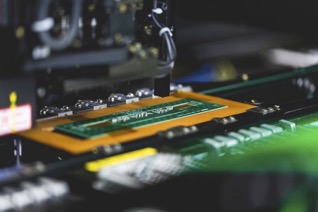
Five popular pcb industry trends in 2021
By Don Kaufman, business development manager, Cirexx International
Electronics Production / Materials Editor Pick materials pcb pcba pcbs printed circuit board productionAcross nearly every industry, consumers and businesses alike continue to demand smarter products that possess the newest technology. As a result, research and development in electronic engineering and design is becoming more important than ever. The growing use of technology in new realms is placing the spotlight on one of the most essential components of nearly every electronic device today – printed circuit boards.
At the root of any piece of technology is a printed circuit board, or PCB. Emerging trends in 2021, coupled with the need for technological implementation, will inevitably call on both PCB design and manufacturing to step into a crucial role that will drive success in our modern world.
In this post, we cover five of the most popular pcb industry trends this year and the impacts that will follow.

Source: CiRexx
What are pcbs?
Pcbs are the foundation in which all electronic components are assembled in any piece of technology. These tiny electronic circuits are among the most important elements of technology ever invented, as they serve as the interconnect for the operation of anything electronic.
Visually, a pcb is a flat plate or base of insulating materials that contains a pattern of conducting material and components. Pcbs can be single-sided, double-sided, or multi-layered, depending on the intended application. Similarly, they can be rigid or flexible, and some technologies may even require both types.
Common applications of pcbs
Any item that possesses an electrical component will need a minimum of one printed circuit board. While there are significant number of applications for pcbs, some of the most common applications include:
Healthcare
- Scanning equipment: X-rays, CT/CAT scanners, ultrasounds
- Blood glucose monitors, heart rate monitors, blood pressure monitors, pacemakers
- Research tools: microscopes, control systems, compressors
Industrial
- Manufacturing equipment: electric drills, assembly machines
- Power inverters
- Measuring equipment: pressure and temperature measuring tools
Consumer Electronics
- Communication devices: smart phones, smart watches, computers, iPads/tablets, laptops
- Entertainment systems: televisions, game consoles, radios, speakers
- Home appliances: refrigerators, dishwashers, microwaves, coffee machines
Automotive
- Navigation systems
- Entertainment systems
- Control systems and engine system management
- Car sensors
Military Aerospace
- Monitoring and communication equipment
- Power supplies
- Flight systems and hardware
Lighting
- Light-emitting diodes (LEDs): residential lighting, cars, digital signage, computer displays
Safety & Security
- Security cameras
- Smoke detectors
- Electronic door locks and motion sensors
5 pcb trends in 2021
Pcbs have become one of the fastest growing industries, with experts projecting it to be worth nearly $76-billion by 2025, according to ResearchAndMarkets.com. Both pcb design and manufacturing trends are moving in parallel with the new standards being set, such as making adaptations to pcb assembly to better fit our digital era. Below is a closer look at five pcb industry trends in 2021.
- High Density Interconnect (HDI) pcbs
In our modern era, the use of advanced automation has become the new normal for people and businesses across the board. From aerospace applications and military communications to new improvements in medical diagnostic tools and wearable technology, the need for smaller parts with faster signal has increased – and therefore so has the demand for HDI pcbs. HDI pcbs provide reliable, high-speed signal and are smaller in size and lighter in weight than other pcbs. They also grant a cleaner circuit route with versatile routing options.
Additionally, HDI pcbs provide smaller trace widths and better wiring density, allowing engineers to pack more function and power into a smaller space. They reduce the need for layering, which in turn lowers the cost of production. For these reasons, HDI pcbs are becoming crucial components in many products and applications.
- High Power Boards
The demand for high power boards, especially those with 48V and higher, is increasing significantly. One reason for this trend is the growing prevalence of electric vehicles, in which voltages are often in the hundreds. Similarly, with new trends in sustainability there has been a higher need for solar panels, which operate at 24V or 28V.
- Internet of Things (IoT)
One of the most notable trends this year has been the need for connectivity among all products – otherwise known as IoT. This coincides with a push for smart devices to become both smaller and more complex. It is only a matter of time before it is standard for pcb manufacturing to include IoT components.
So, how will these requirements call for pcb design to change? Presently, any IoT device requires sensors, wireless connectivity, and power. For example, new IoT devices such as wearable smart watches are getting smaller, therefore needing tinier components that possess the same functionality. These devices are also getting ‘smarter,’ which will require fitting more components into a smaller space than ever before. We can’t forget to mention that consumers expect new IoT devices to sustain an even longer battery life, so pcb design must also ensure reliable power management.
One challenge that manufacturers may face because of this trend is keeping up with the everchanging rules and regulations that come with IoT. As our world’s dependence on connectivity continues to increase, implementing proper security among pcbs will be vital for manufacturers across all industries.
- Flex PCBs
A single board is responsible for managing several functions, making a flexible layout a key component of pcb functionality. Flex pcbs can handle mode stress and mold into any shape or size. Their ability to allow smooth attachment of every component has led to advancements in several new medical instruments.
In addition, flex pcbs are smaller and can withstand tough environments that range from dropping a cell phone to launching a missile. They have also increased capability and better reliability, all while saving space.
Lastly, the innovative materials and characteristics of flex pcbs coupled with the prevalence of IoT is calling for the number of flex PCBs being made to increase significantly.
- Commercial Off-The-Shelf Solutions
Commercial off-the-shelf solutions, or COTS, include pcb components, modules, and boards that come “as is.” COTS components are designed to be easily installed into existing systems.
Aerospace is one area in which we are seeing pcb technology routinely use COTS. New space development solutions have transitioned to using pcb COTS to reduce the costs of major initiatives while keeping the guarantee of quality and safety – all while completing projects at a faster rate.
Pcbs are the core of nearly every electronic device – and that won’t change. Regardless of how technologies span out to new industries and applications, pcbs will always be required.
However, as pcb industry trends continue to reach new heights, they will make a considerable impression on both design and manufacturing. To stay competitive, major printed circuit board companies will have to restructure operations frequently – including making changes to pcb assembly, arrangement, and composition, as well as adapting to meet the increase in demand.
Don Kaufman is business development manager with Cirexx International, has over 33 years of sales and technical experience in the printed circuit board industry.

